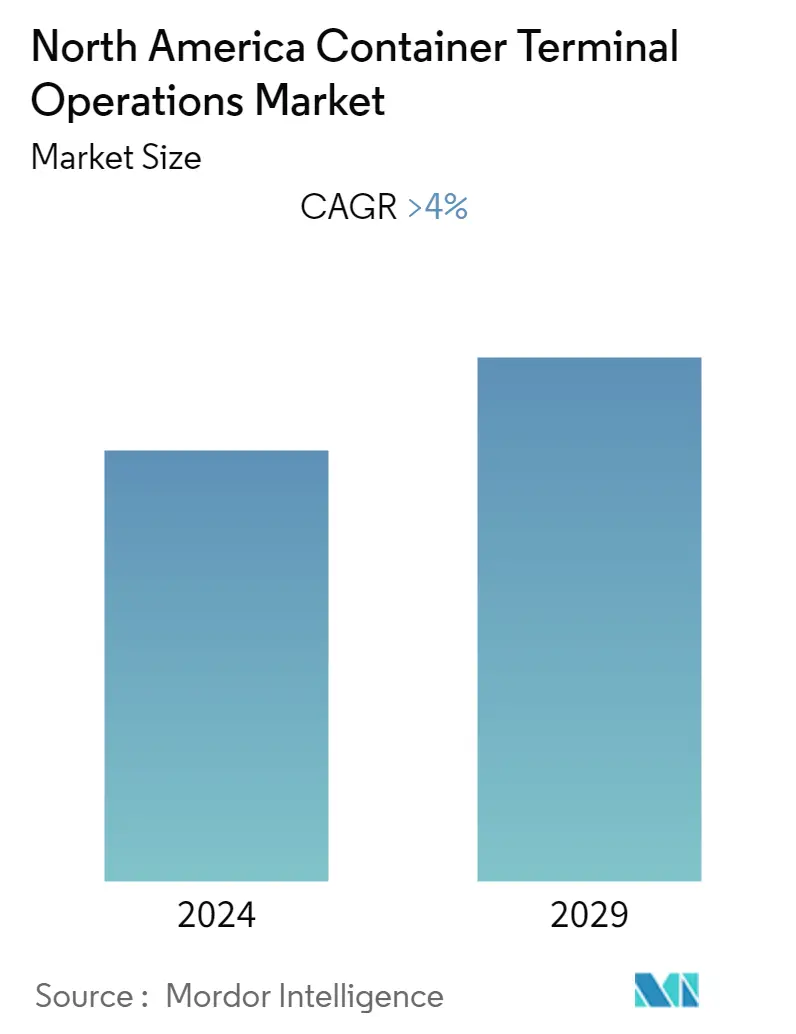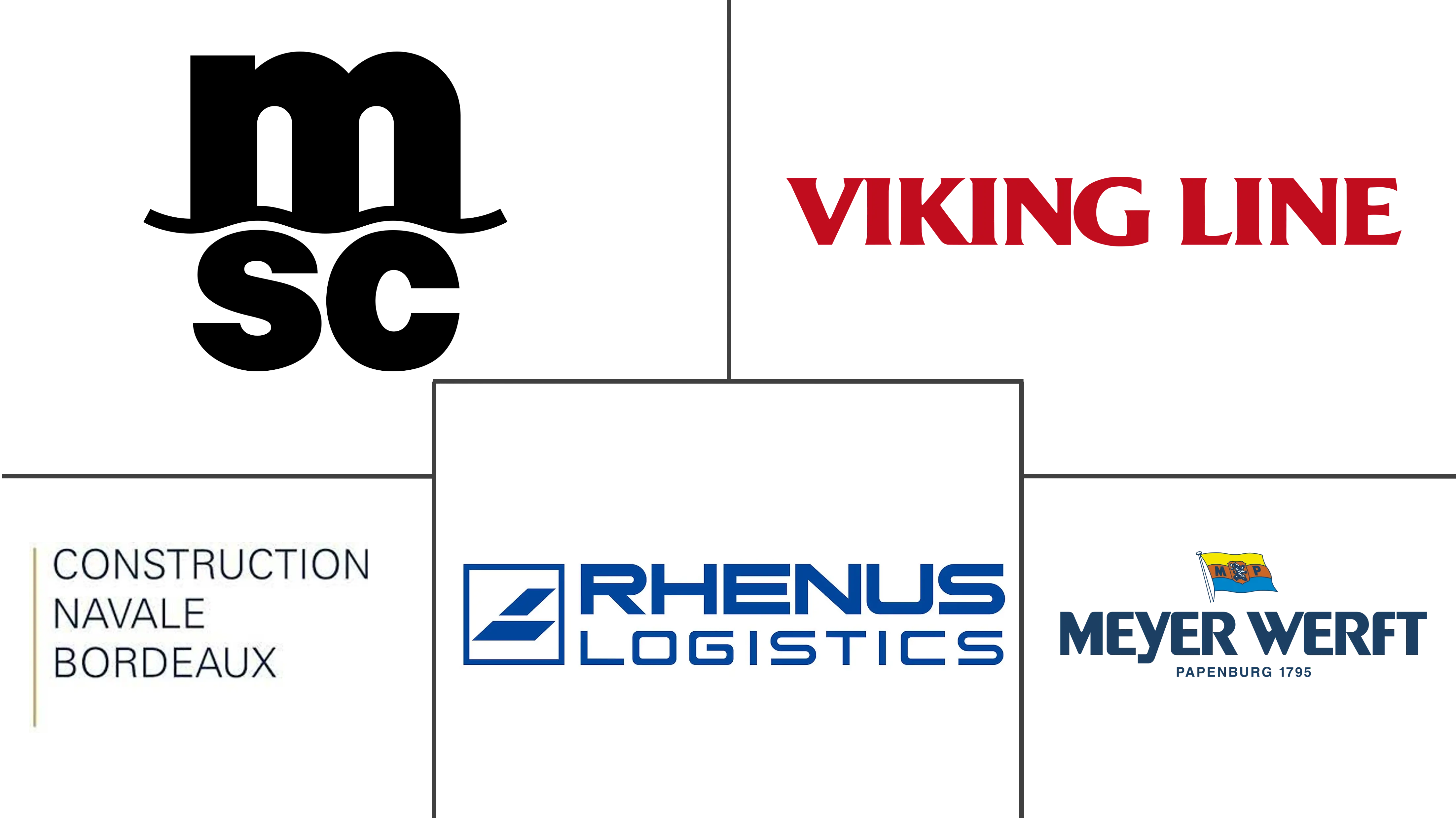Market Size of North America Container Terminal Operations Industry

| Study Period | 2020 - 2029 |
| Base Year For Estimation | 2023 |
| Forecast Data Period | 2024 - 2029 |
| Historical Data Period | 2020 - 2022 |
| CAGR | > 4.00 % |
Major Players
*Disclaimer: Major Players sorted in no particular order |
North America Container Terminal Operations Market Analysis
- The North America Container Terminal Operations Market is anticipated to register a CAGR of greater than 4% during the forecast period. The region is also seeing an increase in the demand for operational efficiency while lowering its environmental effect. In addition, there is anticipated to be an increase in the demand for energy vessels from various private sectors.
- The complexity of container terminal services mostly depends on the kind of shipping and cargo. Cars, goods, crude oil, minerals, and other sorts of cargo are all examples of cargo. To handle and manage different types of cargo, various equipment, skills, and labor are needed. The handling of the ferry services requires several types of ports. Accidents have occurred as a result of the container terminal's operations being less efficient than desired. Therefore, the activities at the container terminal should be perfect and extremely efficient. Operations at container terminals are hence the foundation of the maritime sector.
- The global supply chain in the maritime industry has been facing a series of challenges since the start of the COVID-19 pandemic in early 2020. The North American marine port services industry was plagued by port closures caused by coronavirus outbreaks, port congestions, rising bunker fuel prices, and issues with capacity utilization during the majority of 2020 and 2021. This has led to delays in the shipping industry affecting the freight container supply chain through 2020 to 2022.
North America Container Terminal Operations Industry Segmentation
Companies that run ports, including docking and pier facilities, are part of the container terminal operation sector. Cargo loading and unloading from ships, preparing paperwork for incoming shipments to meet customs requirements, using a computer system to connect cargo with recipients, and loading and unloading cargo onto trucks and trains are among the main tasks.
The North America Container Terminal Operations Market is segmented By Service (Stevedoring, Cargo Handling & Transportation, and Others), By Cargo Type (Dry Cargo, Crude Oil, and Other Liquid Cargo), and By Country (US and Canada). The report offers market size and forecasts for Global Container Terminal Operations Market in value ( USD Billion ) for all the above segments.
| By Service | |
| Stevedoring | |
| Cargo and handling transportation | |
| Others |
| By Cargo Type | |
| Crude Oil | |
| Dry Cargo | |
| Other Liquid Cargo |
North America Container Terminal Operations Market Size Summary
The North America Container Terminal Operations Market is poised for significant growth, driven by an increasing demand for operational efficiency and a shift towards environmentally sustainable practices. The complexity of terminal services, influenced by the types of cargo handled, necessitates advanced equipment and skilled labor. The maritime sector's reliance on efficient terminal operations is underscored by challenges such as port congestion and rising fuel costs, which have been exacerbated by the COVID-19 pandemic. As the industry transitions towards greener energy solutions, ports are exploring new markets and value-added services to adapt to a future with reduced reliance on fossil fuels. This shift is supported by investments in alternative fuels and infrastructure, aligning with global sustainability goals.
The adoption of smart technologies is transforming traditional ports into smart ports, enhancing operational efficiency and reducing costs. Technologies like AI, IoT, and blockchain are being integrated to optimize processes and improve decision-making, thereby increasing productivity and performance. The growing global trade and larger vessel sizes are intensifying the need for these innovations. Key players in the market, including Viking Line and Mediterranean Shipping Company, are focusing on customer satisfaction, capacity expansion, and fleet modernization to maintain competitiveness. Collaborative efforts, such as partnerships with research institutions, are further driving advancements in supply chain solutions across North America. Despite challenges like limited government support for seaport development, the market is expected to expand, fueled by economic growth and industrialization.
North America Container Terminal Operations Market Size - Table of Contents
-
1. MARKET DYNAMICS AND INSIGHTS
-
1.1 Current Market Scenario
-
1.2 Market Dynamics
-
1.2.1 Drivers
-
1.2.2 Restraints
-
1.2.3 Opportunities
-
-
1.3 Value Chain / Supply Chain Analysis
-
1.4 Technological Advancements
-
1.5 Government Regulations and Key Initiatives
-
1.6 Insights into Transshipment Trade
-
1.7 Insights into Containerized and Non-containerized Shipments
-
1.8 Freight Rates and Maritime Transport Costs
-
1.9 Demand-Supply Analysis
-
1.10 Impact of COVID-19 on the Market
-
-
2. MARKET SEGMENTATION
-
2.1 By Service
-
2.1.1 Stevedoring
-
2.1.2 Cargo and handling transportation
-
2.1.3 Others
-
-
2.2 By Cargo Type
-
2.2.1 Crude Oil
-
2.2.2 Dry Cargo
-
2.2.3 Other Liquid Cargo
-
-
2.3 By Country
-
2.4 US
-
2.5 Canada
-
North America Container Terminal Operations Market Size FAQs
What is the current North America Container Terminal Operations Market size?
The North America Container Terminal Operations Market is projected to register a CAGR of greater than 4% during the forecast period (2024-2029)
Who are the key players in North America Container Terminal Operations Market?
Viking Line, Rhenus Group, Mediterranean Shipping Company S A, Construction Navale Bordeaux and MEYER WERFT GmbH & Co., KG are the major companies operating in the North America Container Terminal Operations Market.

